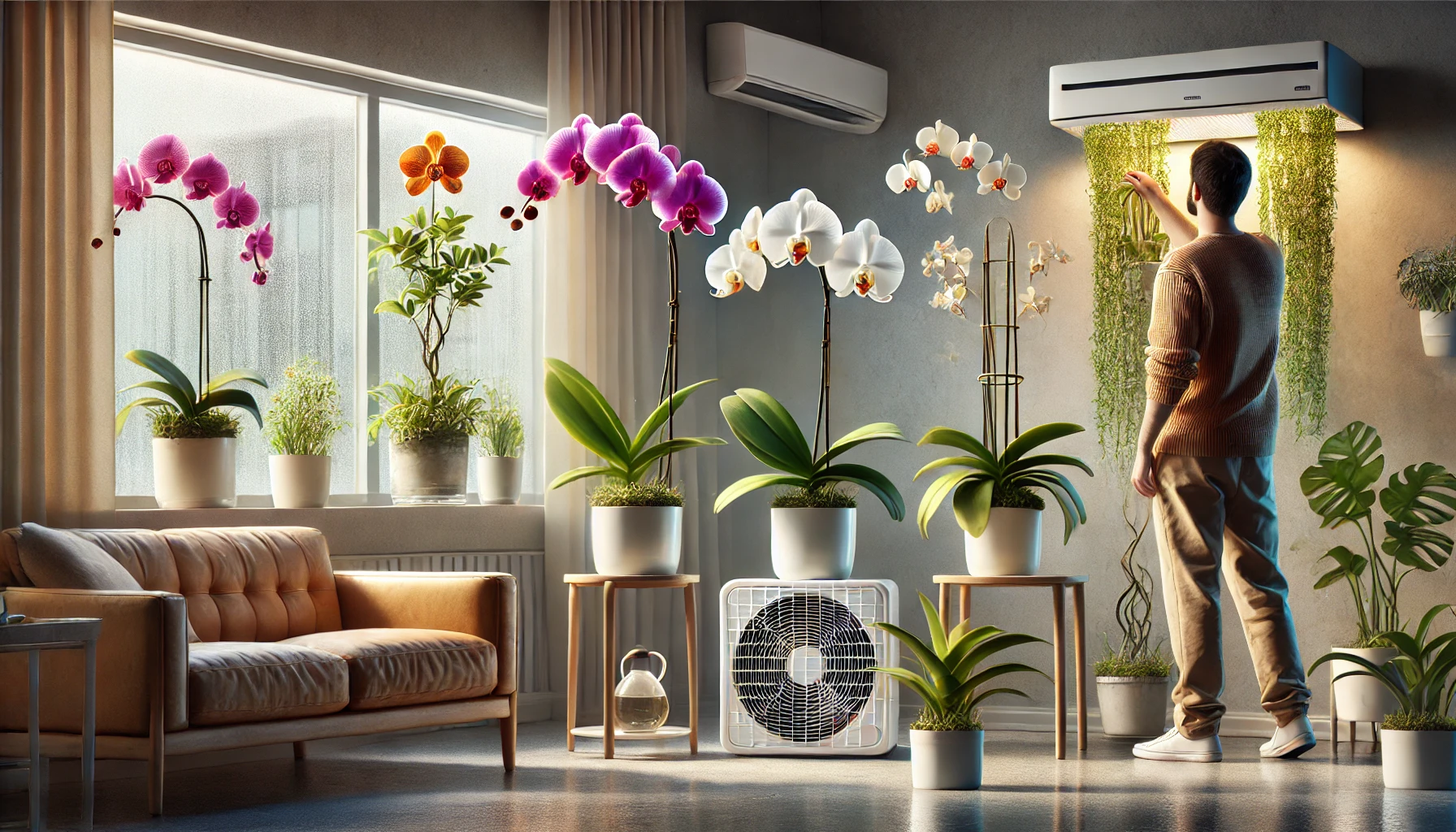Orchids are among the most beautiful and diverse houseplants, but not all orchids thrive in the same environment. Some require bright light, while others prefer shade. Some need high humidity, while others can tolerate drier air. Choosing an orchid that matches your home’s light levels, temperature, and humidity will make caring for it much easier and increase the chances of healthy growth and blooming.
🌱 Why Choosing the Right Orchid Matters
Before selecting an orchid, it’s important to consider several factors. Light is one of the most critical aspects, as some orchids require bright, indirect light, while others thrive in lower light conditions. Temperature also plays a significant role, with some orchids preferring cooler environments and others needing warm, tropical conditions. Humidity levels should also be considered, as orchids generally prefer humidity between 50% and 70%. Lastly, maintenance level is essential—some orchids are easy to care for, while others require specialized attention.
💡 Choosing an orchid that naturally fits your home’s conditions will ensure easier care and better growth!
🌞 Best Orchids for Different Light Conditions
Different orchids require different amounts of light. Some thrive in bright, indirect sunlight, while others do well in low-light spaces.
🌿 Low-Light Orchids (Best for Shady Rooms or North-Facing Windows)
These orchids can tolerate less light, making them perfect for apartments, offices, and homes with small windows.
✔ Phalaenopsis (Moth Orchid) – One of the easiest orchids to grow, blooms for months with minimal care, and prefers medium to low light.
✔ Paphiopedilum (Lady Slipper Orchid) – Thrives in shade or low light conditions, requires consistent moisture, and has unique slipper-shaped flowers.
✔ Ludisia (Jewel Orchid) – Grown for beautiful foliage rather than flowers, thrives in low, indirect light, and prefers high humidity.
💡 If your home has limited natural light, these orchids are your best options!
🌿 Medium-Light Orchids (Best for Bright Indoor Spaces with Indirect Sunlight)
These orchids thrive in spaces with filtered sunlight, such as east-facing windows or rooms with sheer curtains.
✔ Oncidium (Dancing Lady Orchid) – Produces clusters of small, bright yellow flowers, needs good air circulation, and prefers medium to bright, indirect light.
✔ Miltoniopsis (Pansy Orchid) – Blooms with fragrant, pansy-like flowers, prefers cool temperatures and moderate light, and requires consistent moisture and humidity.
✔ Brassia (Spider Orchid) – Distinct spider-like flowers with a sweet fragrance, prefers medium light and high humidity, and flowers last up to two months.
💡 These orchids thrive in well-lit rooms without direct sunlight.
🌿 High-Light Orchids (Best for Sun-Drenched Rooms or South-Facing Windows)
These orchids require strong, indirect sunlight and can even handle a few hours of direct morning sun.
✔ Cattleya (Corsage Orchid) – Needs bright light for proper blooming, produces large, fragrant flowers in various colors, and prefers drying out between waterings.
✔ Vanda Orchid – Requires strong light and warm temperatures, often grown hanging in baskets with exposed roots, and needs daily misting and high humidity.
✔ Dendrobium Orchid – Requires bright, indirect light, blooms multiple times a year with proper care, and can tolerate drier conditions compared to other orchids.
💡 If you have a bright home with large windows, these orchids will thrive!
🌡 Best Orchids Based on Temperature Preferences
Temperature plays a key role in orchid health. Some prefer cooler climates, while others thrive in warm, tropical conditions.
🌿 Cool-Growing Orchids (Best for Homes Kept Below 70°F / 21°C)
✔ Masdevallia Orchid – Prefers 55–65°F (13–18°C) and high humidity.
✔ Cymbidium Orchid – Needs cool winters to bloom.
✔ Miltoniopsis (Pansy Orchid) – Thrives in cool, humid environments.
💡 If you live in a cooler climate or keep your home air-conditioned, these orchids are great choices.
🌿 Intermediate-Growing Orchids (Best for Homes Kept at 65–75°F / 18–24°C)
✔ Phalaenopsis (Moth Orchid) – Ideal for indoor temperatures.
✔ Oncidium (Dancing Lady Orchid) – Thrives in stable, moderate temperatures.
✔ Dendrobium Orchid – Adaptable to various climates.
💡 Most common indoor orchids fall into this temperature range.
🌿 Warm-Growing Orchids (Best for Homes Kept Above 75°F / 24°C)
✔ Vanda Orchid – Loves heat and humidity.
✔ Cattleya Orchid – Thrives in warm conditions.
✔ Brassavola Orchid – Prefers warm temperatures and bright light.
💡 If you live in a warm, tropical climate, these orchids will flourish.
💦 Best Orchids for Different Humidity Levels
Orchids need humidity to thrive, but some tolerate drier conditions better than others.
🌿 Best Orchids for Dry Homes (Low Humidity 30–50%)
✔ Cattleya Orchid – Prefers drying out between waterings and tolerates drier air.
✔ Dendrobium Orchid – Adapts well to various humidity levels.
✔ Phalaenopsis (Moth Orchid) – Can survive in lower humidity but benefits from occasional misting.
🌿 Best Orchids for Humid Homes (High Humidity 60–80%)
✔ Vanda Orchid – Requires daily misting or high humidity to thrive.
✔ Masdevallia Orchid – Needs constant moisture and cool conditions.
✔ Oncidium (Dancing Lady Orchid) – Prefers high humidity but good air circulation.
💡 If your home is dry, use a humidity tray or humidifier to help moisture-loving orchids thrive.
🚫 Common Mistakes When Choosing an Orchid
❌ Choosing a high-light orchid for a low-light space – Vandas won’t thrive in a dim room.
❌ Keeping a cool-growing orchid in a warm home – Masdevallia orchids suffer in hot conditions.
❌ Ignoring humidity needs – Some orchids won’t bloom without proper moisture levels.
❌ Selecting a high-maintenance orchid without time for care – If you’re a beginner, start with Phalaenopsis.
🛡 Final Tips for Selecting the Right Orchid for Your Home
✔ Match your orchid to your home’s light, temperature, and humidity levels.
✔ If you’re a beginner, start with an easy-care orchid like Phalaenopsis.
✔ Provide proper air circulation to prevent mold and pests.
✔ Use a grow light if your home doesn’t get enough natural light.
✔ Be patient—some orchids take time to adjust before blooming!
By choosing an orchid that naturally fits your home’s environment, you’ll enjoy healthy growth, beautiful blooms, and stress-free care! 🌸✨
